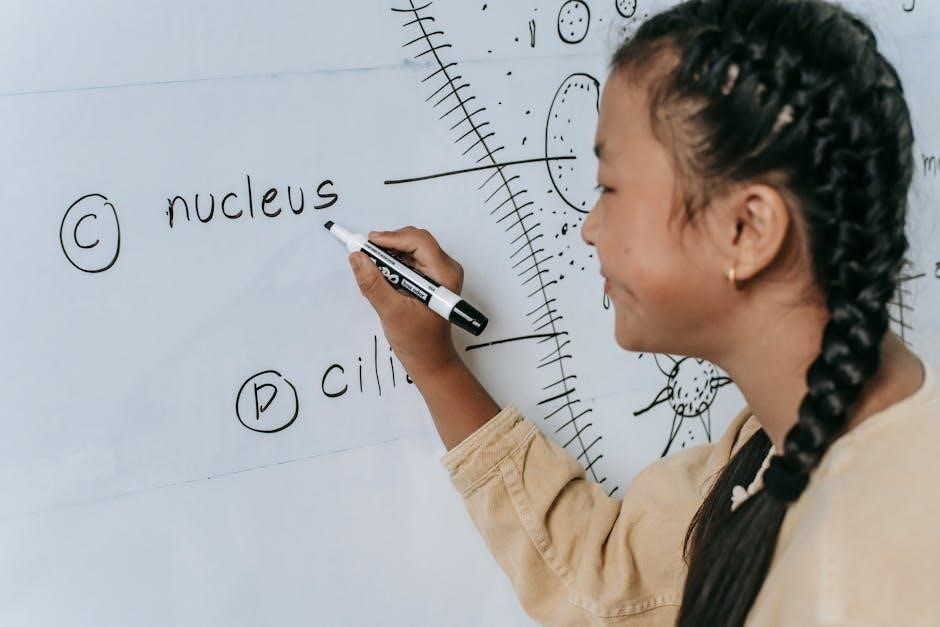The firefighter test is a critical step in becoming a firefighter, requiring both physical and mental preparation․ This guide offers expert tips, practice questions, and strategies to help you excel․
1․1 Overview of the Firefighter Exam
The firefighter exam is a comprehensive assessment designed to evaluate candidates’ suitability for the role․ It typically consists of a written test and a physical ability test (PAT)․ The written exam includes multiple-choice questions that measure knowledge in areas such as firefighting procedures, safety protocols, and problem-solving skills․ The PAT assesses physical strength, endurance, and agility through tasks like climbing ladders, carrying equipment, and simulating rescue operations․ Both components are critical for determining a candidate’s ability to perform firefighting duties effectively․ The exam is a key step in the hiring process, ensuring only qualified individuals advance to further stages․ Preparation is essential, as the test is challenging and competitive․ This guide provides insights into the exam’s structure, helping candidates understand what to expect and how to prepare successfully․
1․2 Importance of Preparation
Preparation is crucial for success in the firefighter exam, as it is a highly competitive and challenging process․ Understanding the exam format, practicing relevant questions, and building physical endurance significantly improve performance․ A well-structured study plan ensures candidates cover all critical areas, from firefighting procedures to problem-solving skills․ Without proper preparation, applicants may struggle with time constraints and question types, reducing their chances of scoring high․ Utilizing study guides, practice tests, and video tutorials helps candidates familiarize themselves with the exam structure and identify weak areas․ Physical training is equally important, as the PAT demands strength, stamina, and agility․ Consistent practice builds confidence and readiness, ensuring candidates perform at their best on test day․ Preparation not only enhances knowledge but also instills the mental and physical resilience needed for a career in firefighting․

Understanding the Written Exam
The firefighter written exam evaluates essential skills like problem-solving, reading comprehension, and fire safety knowledge․ It features multiple-choice questions and scenario-based problems, assessing critical thinking under time constraints․
2․1 Format and Structure of the Written Test
The firefighter written test typically consists of multiple-choice questions designed to assess critical thinking, problem-solving, and knowledge of firefighting procedures․ The exam is divided into sections, each focusing on specific areas such as fire safety regulations, emergency response protocols, and mechanical reasoning․ Candidates are usually given a set time limit to complete the test, emphasizing the importance of time management․ The questions are often scenario-based, requiring applicants to apply their knowledge to real-life situations․ Practice tests and study guides provide insight into the format, helping candidates familiarize themselves with the question types and structure․ Understanding the test format is crucial for effective preparation, as it allows candidates to focus on improving their weaknesses and building confidence in their abilities․ Proper preparation ensures candidates can navigate the test efficiently and demonstrate their skills effectively․
2․2 Key Question Types and Topics
The firefighter written test includes multiple-choice, true/false, and scenario-based questions to evaluate a candidate’s knowledge and reasoning skills․ Key topics cover fire behavior, safety protocols, and emergency procedures․ Questions often focus on fireground operations, hazardous materials response, and rescue techniques․ Mechanical aptitude and basic math skills are also tested, as firefighters must handle equipment and calculate factors like water pressure․ Another critical area is fire prevention and building codes, ensuring candidates understand regulatory standards․ Additionally, questions may assess spatial reasoning and map-reading abilities, essential for navigating emergency sites․ Understanding these topics and question types is vital for targeted study․ Focusing on weak areas and practicing with sample questions can significantly improve performance․ A thorough review of these subjects ensures candidates are well-prepared for the exam and confident in their abilities to handle real-world scenarios effectively․

Physical Ability Test (PAT)
The Physical Ability Test evaluates a candidate’s strength, endurance, and agility through tasks simulating real firefighting scenarios․ It assesses physical fitness required for firefighting, ensuring candidates can perform demanding tasks effectively․ Preparation is crucial for success․
3․1 Overview of the Physical Ability Test
The Physical Ability Test (PAT) is a critical component of the firefighter selection process, designed to evaluate a candidate’s physical fitness and ability to perform the demanding tasks of firefighting․ The test simulates real-life firefighting scenarios, such as carrying heavy equipment, climbing stairs, and dragging hoses, to assess strength, endurance, and agility․ Candidates must demonstrate the physical stamina required to handle emergencies effectively․ Preparation is essential, as the PAT pushes individuals to their limits․ It is not just about passing but ensuring readiness for the challenges of the job․ Regular exercise and practice are recommended to build the necessary strength and endurance․ The PAT is a key step in determining whether a candidate has the physical capabilities to succeed as a firefighter․
3․2 Components of the Physical Ability Test
The Physical Ability Test (PAT) consists of several standardized tasks designed to simulate the physical demands of firefighting․ These tasks are typically performed in a sequence to assess endurance, strength, and agility․ Common components include stair climbing with weighted equipment, dragging hoses, carrying heavy tools, and navigating obstacle courses․ Some tests also include ladder climbs, forcible entry simulations, and search-and-rescue drills․ Each task is timed to ensure candidates meet the required standards․ The PAT is rigorous, requiring candidates to demonstrate both speed and accuracy․ Proper training and conditioning are essential to successfully complete all components․ Candidates are evaluated on their ability to perform these tasks safely and efficiently, reflecting the physical challenges faced by firefighters in real emergencies․ Preparation for the PAT should focus on building muscular endurance, cardiovascular fitness, and coordination․

Study Strategies for Success
Effective study strategies include active learning, practice tests, and staying organized․ Consistency, time management, and focusing on weaknesses are key to achieving success;
4․1 Creating a Study Schedule
A well-structured study schedule is essential for success in the firefighter test․ Start by assessing your current knowledge and identifying areas that need improvement․ Allocate specific time slots for each subject, ensuring a balance between written and physical preparation․ Set realistic goals for each study session and prioritize challenging topics like fire safety laws or hydraulic calculations․ Incorporate regular practice tests to monitor progress and adjust your schedule as needed․ Use a calendar or planner to stay organized and track your advancements․ Remember to include breaks to avoid burnout and maintain focus․ Consistency is key, so commit to your routine and stay disciplined․ By following a structured plan, you’ll build confidence and readiness for the exam․ Avoid last-minute cramming by spreading your study efforts evenly over time․
4․2 Effective Test-Taking Techniques
Mastering effective test-taking techniques is crucial for achieving a high score on the firefighter exam․ Start by carefully reading each question and identifying key terms to understand what is being asked․ Manage your time wisely, allocating a set amount to each section to avoid running out of time․ Eliminate obviously incorrect answers first to increase your chances of selecting the right one․ Stay calm and focused, as stress can impair decision-making․ Use the process of elimination for challenging questions, and mark those you’re unsure about to review later if time permits․ Practice these strategies during mock exams to build confidence and improve accuracy․ Remember, consistency and composure are key to performing your best on test day․

Practice Tests and Mock Exams
Practice tests and mock exams are essential for familiarizing yourself with the firefighter exam format, improving time management, and reducing test-day anxiety․ They help identify weak areas for targeted improvement․
5․1 Benefits of Taking Practice Tests
Taking practice tests offers numerous benefits for firefighter exam preparation․ They familiarize candidates with the exam format, reducing anxiety and stress on test day․ Practice tests identify weak areas, enabling targeted studying and improvement․ They enhance time management skills, crucial for completing the exam within the allotted time․ Regular practice builds stamina and focus, ensuring optimal performance throughout the test․ Practice tests provide a realistic assessment of preparedness, guiding necessary adjustments to study plans and strategies․ Repeated exposure to test-like conditions reinforces learning and improves retention of key concepts․ Consistent practice boosts confidence, leading to better overall performance․ Incorporating practice tests into a study routine helps candidates approach the firefighter exam with greater assurance and readiness, increasing their chances of success․
5․2 Analyzing Your Performance
Analyzing your performance on practice tests is a critical step in improving your firefighter exam results․ By reviewing your scores and answers, you can identify strengths and areas needing improvement․ This process helps you understand where to focus your study efforts, ensuring efficient use of time․ Tracking progress over multiple practice tests reveals trends and highlights consistent weak points․ Understanding the types of questions you struggle with allows you to target specific topics or skills․ Additionally, analyzing time management during tests helps refine pacing strategies, ensuring you complete all sections within the allotted time․ Regular performance reviews build self-awareness, enabling adjustments to study plans and test-taking techniques․ This iterative process enhances overall readiness and boosts confidence for the actual exam․

Oral Interview Preparation
Oral interview preparation is crucial for firefighter candidates․ It involves researching common questions, practicing responses, and refining communication skills․ Preparation helps build confidence and ensures a professional presentation, increasing success chances․
6․1 Common Interview Questions
Firefighter oral interviews often include a mix of behavioral, scenario-based, and motivational questions․ Common questions revolve around teamwork, leadership, and problem-solving․ Candidates may be asked, “Why do you want to become a firefighter?” or “Describe a time you worked in a high-stress environment․” Interviewers also assess knowledge of firefighting practices and physical demands․ Questions like “How would you handle a difficult teammate?” or “What would you do in a life-threatening situation?” are frequent․ Understanding the fire department’s values and mission can help tailor responses․ Practicing answers to these types of questions is essential for confidence and clarity․ Researching the department and reviewing common queries ensures preparedness․ Demonstrating passion, resilience, and a commitment to public service is key to making a strong impression during the interview․
6․2 Tips for a Successful Oral Interview
To excel in the firefighter oral interview, preparation and confidence are critical․ Research the fire department and practice answering common questions to demonstrate knowledge and enthusiasm․ Dress professionally, as appearance reflects professionalism and seriousness․ Maintain good body language, such as sitting up straight and making eye contact, to show confidence․ Speak clearly and concisely, avoiding filler words․ Highlight your relevant skills, such as teamwork, leadership, and problem-solving abilities․ Be honest and authentic in your responses, showcasing your passion for the role․ Follow up with a thank-you note to express gratitude and reinforce your interest․ Stay calm and composed, as nervousness is natural but manageable․ Show enthusiasm for the fire service and align your answers with the department’s values․ Preparation and positivity are key to leaving a lasting impression․

Medical Exam Requirements
The firefighter medical exam is rigorous, assessing vision, hearing, cardiovascular health, and pulmonary function․ It ensures candidates can handle physical demands and perform effectively in emergencies; Preparation is key․
7․1 Medical Screening Process
The firefighter medical screening process is a critical step in the hiring process, ensuring candidates meet strict health standards․ It typically begins with a comprehensive medical history review, followed by a physical examination․ Key assessments include vision and hearing tests, cardiovascular evaluations, and pulmonary function tests․ Candidates may also undergo blood work, urinalysis, and drug screening․ A doctor will check for any pre-existing conditions that could hinder job performance or pose a risk in emergency situations․ The process also evaluates physical strength, flexibility, and overall fitness․ Candidates are advised to disclose any medical conditions upfront to avoid disqualification later․ The medical screening ensures that only those capable of handling the physical and mental demands of firefighting move forward in the process․ Preparation is essential, as failing this step can prevent further progression․
7․2 Physical Health Requirements
Firefighter candidates must meet rigorous physical health requirements to ensure they can perform demanding tasks safely and effectively․ These requirements typically include strong cardiovascular endurance, muscular strength, and flexibility․ Candidates are expected to pass standardized physical assessments, such as running tests, strength evaluations, and simulations of firefighting tasks․ Vision and hearing must also meet specific standards to ensure clarity in emergency situations․ Body weight and body fat percentages may be assessed to ensure a healthy physical condition․ These requirements are designed to mirror the physical demands of the job, such as climbing ladders, carrying heavy equipment, and working in challenging environments․ Meeting these standards is crucial for both performance and safety․ Candidates are encouraged to maintain a healthy lifestyle and engage in regular physical training to meet these expectations successfully․

Background Check and Psychological Evaluation
A thorough background check and psychological evaluation ensure candidates are mentally fit and trustworthy for firefighting roles, assessing criminal history, personal stability, and emotional readiness for high-stress situations․
8․1 What to Expect in a Background Check
A background check for firefighter candidates is a comprehensive process that verifies an individual’s personal history to ensure trustworthiness and suitability for the role․ It typically includes a review of criminal history, with felony convictions often disqualifying candidates, while misdemeanors may be evaluated on a case-by-case basis․ Employment history is also scrutinized to assess reliability and work ethic․ Additionally, credit checks may be conducted to evaluate financial responsibility, as poor credit could indicate poor judgment․ Candidates should also expect interviews with personal references to gain insight into their character․ Any discrepancies in the information provided during the application process can lead to disqualification․ It is crucial for candidates to be honest and transparent throughout this process, as firefighters must uphold public trust․ Understanding these expectations helps candidates prepare and avoid potential issues during the screening․
8․2 Preparing for Psychological Assessments
Psychological assessments for firefighter candidates evaluate mental fitness and suitability for the demanding nature of the job․ These tests often include personality evaluations to assess traits like decision-making, emotional stability, and teamwork․ Candidates may also face cognitive tests to measure problem-solving skills and judgment․ Additionally, scenario-based questions are used to gauge reactions to high-stress situations․ To prepare, candidates should understand the test format and practice answering questions honestly, reflecting their true personality․ Staying mentally fit through stress management techniques can improve performance․ Reviewing ethical standards and fire department values is also crucial, as the assessments align with these principles․ Being well-rested and mentally sharp on test day is essential for accurate results․ Preparation ensures candidates present their best self, increasing their chances of success in this critical phase of the firefighter test process․

Final Test-Day Tips
Arrive early, manage stress, and maintain focus․ Time management is crucial, so prioritize tasks and stay calm․ A positive mindset enhances performance and ensures readiness for the challenges ahead․
9․1 Strategies for Test Day
On test day, arrive early to avoid last-minute stress and familiarize yourself with the location․ Dress comfortably and bring all required documents․ Stay hydrated and eat a nutritious meal to maintain energy levels․ During the test, read each question carefully and manage your time effectively, allocating a set amount to each section․ Skip difficult questions initially and return to them later to avoid wasting time․ Stay focused and avoid distractions․ If you encounter a challenging question, eliminate incorrect answers to increase your chances of selecting the right one․ Maintain a positive mindset and remind yourself of your preparation․ Avoid panicking, as stress can impair performance․ Take deep breaths to stay calm and composed throughout the exam․ A well-rested and mentally prepared candidate is more likely to perform at their best․
9․2 Managing Stress and Anxiety

Managing stress and anxiety is crucial for optimal performance on test day․ Practice relaxation techniques such as deep breathing, meditation, or positive visualization to calm your nerves․ Engage in light physical activity, like a short walk or stretching, to reduce tension․ Ensure you get a good night’s sleep before the exam to maintain mental clarity․ Avoid caffeine and sugary foods that can increase anxiety levels․ Stay present and focus on the task at hand, rather than worrying about the outcome․ Remind yourself of your extensive preparation and trust in your abilities; If anxiety arises during the test, take a moment to collect your thoughts before proceeding․ Lastly, arrive early to avoid added stress and maintain a positive mindset throughout the process․ By managing stress effectively, you can approach the exam with confidence and composure․

Leave a Reply